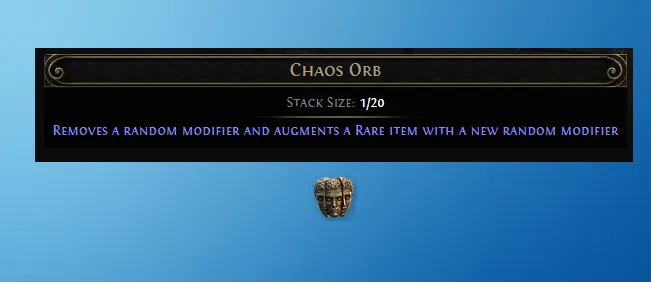Cart Empty
Continue ShoppingChaos Orbs are one of those classic Path of Exile currencies that almost every player ends up using sooner or later. In Path of Exile 2, they work a bit differently than you might expect if you're coming from PoE1, and understanding those changes early can save you a lot of pain (and wasted items).
This guide breaks down what Chaos Orbs actually do, how to get them, how to use them wisely, and the common mistakes players fall into. I'll also give some practical, down-to-earth tips based on actual gameplay, not just theory.
In PoE 2, a Chaos Orb is a Path of Exile 2 currency item used to modify a rare item. But unlike PoE1 — where it rerolls all affixes — the PoE 2 version has a simpler but more tactical effect:
It removes one random modifier from a rare item and adds a new random modifier.
That's it. One affix gone, one affix added. Think of it like “re-rolling a single slot” instead of wiping the whole item. It still has RNG, but the risk is easier to understand, and the outcomes are more controlled compared to the old version.
If you're coming from PoE1, this difference alone changes how you should think about crafting.

Chaos Orbs can drop anywhere, starting at drop level 12. They're not super rare, but they're also not something you'll see every minute.
Where most players get them:
There are no special vendor recipes for Chaos Orbs in PoE 2 right now, so drops are your main source.
Since they drop everywhere, don't overthink farming — just play normally and they'll come.
You can only use a Chaos Orb on rare items, since they need modifiers to remove and replace.
When you use one:
The important thing here is the random part. You might remove a bad mod… or you might remove your best mod. You don't get to choose.
Absolutely. Even though you're only swapping one affix at a time, you can still ruin a great piece by accident.
Very — but only when used wisely, and usually not on items that are already great.
Here's the honest truth most guides don't say:
Chaos Orbs are best early to mid-game, not late-game.
Late-game crafted items often need precise control, and Chaos Orbs just aren't designed for precision in PoE 2.
Even in PoE 2, Chaos Orbs are still part of the “middle-tier” currency value system. They're not the main unit of trade like in PoE1 leagues, but players still use them as a stable, convenient resource.
The usual rule applies:
If you don't have an immediate crafting plan, it can be smarter to save or trade them.
Since high-end crafting in PoE 2 uses many different kinds of orbs and stones, Chaos Orbs sit in that middle spot — useful, but not something you want to spam without a purpose.
PoE 2 introduces Omens, special inventory items that modify how your next Chaos Orb behaves. These are super fun to experiment with, and they can actually make Chaos Orbs a lot more controlled.
Here are the ones that matter:
These are extremely helpful if you're trying to fix a rare item without losing your key mod. In PoE 1 this kind of control simply didn't exist, so this is a big win for crafters.
Here are the mistakes almost every new player makes at some point:
Even a perfect roll won't save a bad base item.
The Chaos Orb might delete your best stat.
Many players cry here. Don't be one of them.
Just because you can reroll doesn't mean you should.
If you have an Omen that helps control prefixes/suffixes, always use it.
PoE 2's Chaos Orb is more surgical, but still dangerous.
Treat it like a scalpel, not a sledgehammer.
No — only rare items.
Yes. Chaos Orbs remove a random mod, and prefixes/suffixes are part of that RNG unless you use a special Omen.
Always. Base > Modifiers.
There is no fixed number — it's all RNG.
But most players stop once they get “good enough.”
Usually, yes — you'll know what you need once your build settles.
Definitely. Higher-tier currency gives you more control.
Chaos Orbs in PoE 2 are simple on the surface — remove one mod, add one mod — but they open up a lot of crafting decisions. They're great for early to mid-game improvements and fixing rares that are “almost good.” But they're risky, random, and not ideal for high-end crafting unless paired with the right Omens.
If you treat them as a tool for shaping items rather than perfectly finishing them, you'll get way more value and avoid the common pitfalls players fall into.